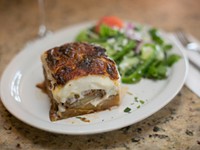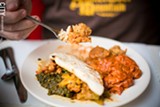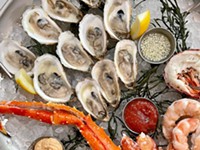[
{
"name": "500x250 Ad",
"insertPoint": "5",
"component": "15667920",
"parentWrapperClass": "",
"requiredCountToDisplay": "1"
}
]
It is not Christmas at Royal India. Crouched on the edge of the commercial sprawl that is Henrietta, Royal India sits apart from the celebration of America's No. 1 consumer holiday, an oasis in a desert of faux holiday cheer. Mommy is not kissing Santa Claus here. Nor is anyone bemoaning giving their heart away last Christmas. They are too busy refilling their plates from what is arguably one of the best, and the cheapest, Indian buffets in town. And then going back for seconds, and then thirds of standards like chicken makhani and navratan korma, and harder-to-find dishes like Hyderabadi eggplant curry or chaat. It's not Christmas here, but it doesn't have to be: Royal India's buffet is a balm for your aching soul and depleted wallet any day of the year.
When Jasvir Grewal, a native of Punjab who most recently lived and worked in Buffalo, decided to move to Rochester to open up an Indian restaurant of his own, he picked a nearly ideal location for his new enterprise: about a half-mile from RIT and right next door to Spice Bazaar, the largest Indian grocery store in the area. But he also opened up in one of the most competitive areas of the county in terms of Indian food. Four excellent Indian restaurants — three of them offering superb buffets — are within a mile of his restaurant, and the kitchen door of one of the best of them abuts Royal India's parking lot.
According to Grewal's daughter Jaspret Kaur, her father initially priced his menu — and his buffet — in accordance with what everyone else was charging. But he quickly amended his business strategy, lowering his prices to appeal to cash-strapped students, relying on volume to make up for the smaller price tag (lunch buffet costs $7.95, $10.95 for dinner). So far that strategy has paid off. It would be very difficult to find a better or more filling lunch anywhere in Rochester for less than you would pay to do a couple of loads of laundry at the laundromat.
Royal India does not get by on its looks, though. The restaurant's décor is a hodgepodge of the various other restaurants that have inhabited the space before it. The lighting is dim. The music coming out of the speakers is a little scratchy. Everything looks more than a little battered and tired.
Everything, that is, except for the magisterial buffet of Indian food that forms an L around one side of the room. A small salad bar full of lettuce, tomato, cucumber, and red onion shares space with a compact chaat bar, offering spiced potatoes, puffed-up pieces of papadum, potato and pea samosas, and the usual trio of chaat sauces — a creamy white yogurt sauce, mint and coriander chutney, and a tangy dark brown tamarind sauce. All of it is exceptionally fresh-looking and tasting (even the dough on the samosas still had a bit of crunch to it, something that's not easy to do on a buffet).
Assuming you haven't already filled your plate, and your stomach, to capacity in this the smallest part of the buffet, turn right and you will be facing trays full of crispy onion bhajia (deep-fried fritters made from onion and lentil flour) and medu vada (a savory analog of the doughnut also made with lentil flour). These, in turn, are next to trays of rice with green peas or rice with cumin seeds (jeera rice). And then comes a long parade of curries. Masala eggplant sits next to bhindi masala, which is next to a steaming tray of dal, and a pan full of kidney beans and black lentils that may convince you that chili does not actually need meat to be delicious. Then, a chorus line of Indian-buffet favorites: navratan korma, chicken curry, vegetable vindaloo, saag paneer, chicken makhani, and tandoori chicken legs. An assortment of Indian desserts — I tend to favor the creamy kheer because everything else is tooth-achingly sweet — bring up the rear.
There's nothing — with the exception of the eggplant — that makes this buffet stand apart from its peers at first glance. But dig in and you'll notice that it tastes a bit fresher than the average, the flavors are bright and clean rather than muddy. The navaratan korma, for instance, has the typical bag of frozen vegetables as its base, but Grewal also adds in a generous amount of very fresh cauliflower florets to give the dish some body. The chicken makhani, often made in Indian restaurant kitchens by adding spices to canned tomato soup, has a real depth of flavor and a nice round mouth-feel without the tinny aftertaste of the shortcut version of the dish. The spinach in the saag paneer even retained a bit of its green color — an indication that some, if not all of the greens, in the dish were fresh rather than frozen. I was also gratified to discover that the paneer, a homemade cheese, had the slightly loose texture of fresh-made cheese rather than the denser, spongy feel of the mass-produced version of the product.
But about that eggplant I mentioned earlier: if you eat nothing else when you visit Royal India, the baingan masala entrée ($12) is not to be missed. For those familiar with Indian food as a source for creamy sauces in which to dip bits of naan, this dish — more Punjabi than southern Indian — is a drier curry. The sauce takes a backseat to the tiny eggplants, onions, and tomatoes that have been stir-fried in it. I've had baingan masala before, but all of the other versions have cut the eggplants in half, resulting in mushy eggplant and ultimately a soupy mess of a dish. Keeping the vegetable whole allows the flavors to concentrate, and the eggplant to obtain an almost meaty texture that is eminently satisfying. Against the smoky, tangy background of the sauce, the faint bitterness of the eggplant stands out sharply, balancing and ultimately unifying the best dish on this, or any, Indian buffet I've sampled in the Rochester area.
Latest in Dining Reviews
More by James Leach
-

DINING REVIEW: Orange Glory Cafe
May 15, 2013 -

Dish 2013: Updating the kiddie menu
May 8, 2013 -

DINING REVIEW: Opa Authentic Greek Koozina
May 1, 2013 - More »



